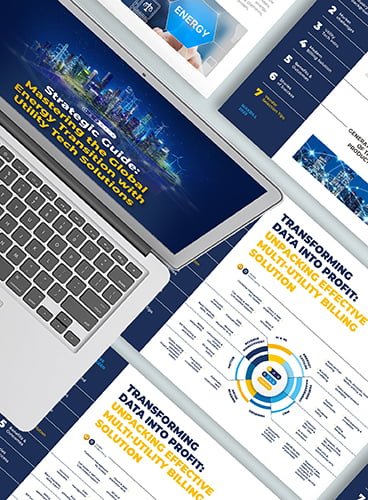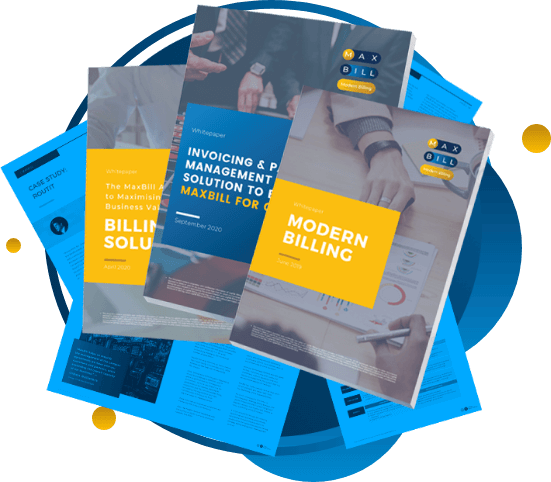Content Authenticity Statement
100% of this article was generated by me, the human. I am the author of MaxBill Knowledge Hub for energy and utility decision-makers, LinkedIn Newsletters “Power Up with MaxBill”, and a keynote webinar speaker on E&U trends.
AI in utilities looks risky because it’s difficult to anticipate ROI. It’s fair, as one expert at Digital Think Tanks of UK Utility Week once stated that ‘an overly enthusiastic or too liberal approach to exploring it could “bankrupt utilities”.
However, successful business cases of implementing AI prove this – AI is ‘the now’ for forward-thinking utilities in many ways, especially when it comes to productivity and efficiency.
Right before launching the MaxBill AI-billing and Product Catalog, we had a prospect (details are under NDA), a renewable energy supplier, that could not get the investor’s interest because of the lack of transparent, auditable financial operations.
So, they were the first to be reached out to give it a try with our next-gen solution – AI billing, supporting compliance, financial audits, and stakeholder reporting. As a result, they got their ops improved (we won’t dive into this part of case study) and the tech capacity to ensure a complete audit trail and billing transparency – automatically.
So, in this piece, we’ll talk about AI in utilities but through a practical lens. This “lens” is the combination of
- MaxBill teams’ expertise in the field of energy and utility
- knowledge from consistent industry networking events
- collabs with partners that leverage AI to deliver extra value to the clients
- opinions of MaxBill R&D visionaries on what’s next for utilities.
Without further ado, let’s hit the road.
Key Takeaways
- AI Act in Europe obliges businesses to leverage AI safely
- The non-compliance might cost E&U businesses from 1.5% of turnover to 7% of worldwide revenue
- We see that AI ‘creepled’ most to customer service, financial optimisation, energy demand and grid optimisation.
- AI in revenue cycle management for energy and utilities means the full optimisation of core processes from product catalog creation and automated charging to partner management and revenue reconciliation.
- MaxBill AI billing and product catalog is a next-gen AI-powered solution for forward-thinking utilities
- To start leveraging AI, utility CIOs should focus on low-risk, high-impact use cases, such as document triage or admin automation.
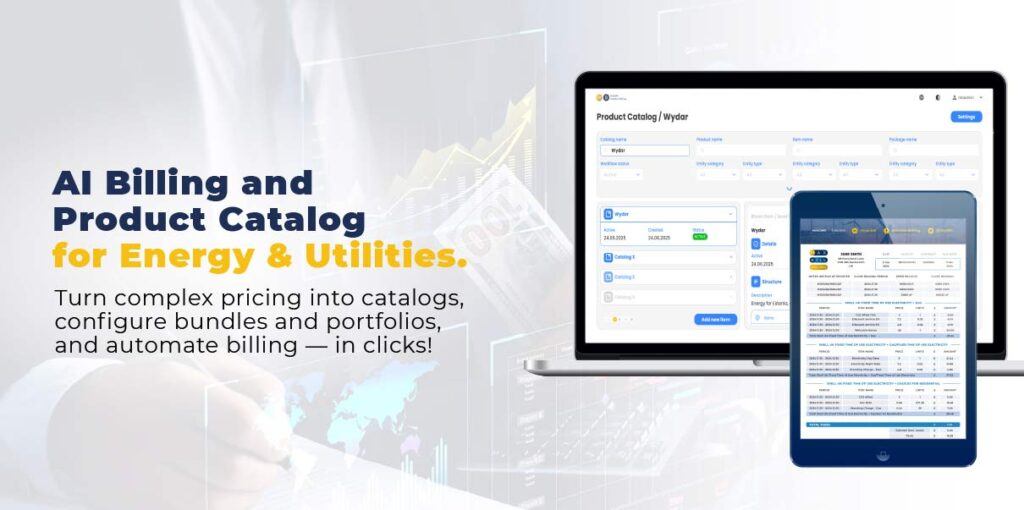
What is AI in Utilities?
Artificial Intelligence in energy and utilities represents autonomous systems designed to execute tasks and make decisions without human participation. In the sector, it’s being applied in different operational areas, from customer service to network management.
The key goals of such technology are the enhancement of efficiency and service delivery and, in the meantime, keeping low-cost to serve.
Today, you can find agentic AI, a key form of AI in utilities. At MaxBill, for example, we deliver an AI-powered self-service portal for utilities to intelligently personalise customer journeys, simplify access to services, and significantly decrease the need for manual support.
Embedded AI agents will be built into more than a third of all enterprise applications, making natural-language conversation the primary user interface. These agents will also handle about 15% of routine decisions, freeing people from repetitive tasks and unlocking a new level of productivity.
Artificial intelligence in energy and utilities: AI Act
AI solutions in utilities are closely linked to data. In many use cases, to the customer’s one. So, MEPs and the Council have agreed on a legislative proposal to ensure that AI in Europe is safe, upholds fundamental rights and democracy, and enables businesses to thrive and grow. This is how the Artificial Intelligence Act was released.
The non-compliance may vary here: from 7.5 million euros, or 1.5% of turnover to 35 million euros or 7% of worldwide revenue. It all depends on the nature of the violation and the company’s size.
Now, what utilities cannot do according to the Artificial Intelligence Act?
- Categorise individuals based on sensitive characteristics like political, religious, or philosophical beliefs, sexual orientation, and race,
- Scrape untargetted facial images from the internet or CCTV footage to create facial recognition databases,
- Use AI for emotion recognition in workplaces and educational institutions
- Assign scores to individuals based on their social behaviour or personal characteristics,
- Manipulate human behaviour in a way that circumvents free will,
- Exploit the vulnerabilities of individuals based on age, disability, and social or economic situation.
In the meantime, innovation in the utilities industry is highly encouraged by authorities. Utilities can:
- Join regulatory sandboxes that represent controlled environments where businesses, especially SMEs, can test and develop innovative AI solutions. They allow for experimentation and innovation without the immediate pressures of full regulatory compliance.
- Participate in real-world testing environments, facilitated by national authorities, that enable SMEs to train and refine their AI systems in practical settings. They say that this hands-on experience helps businesses optimise their AI applications and bring well-tested products to market.
- Collaborate with other businesses, research institutions, and regulatory bodies to experiment on technology trends in the utilities industry. This leads to shared knowledge, resources, and advancements in AI technology, benefiting the entire industry (like we do with Tillix, for example).
Additionally, the Act aims to prevent undue pressure from industry giants by creating a level playing field. This includes measures to ensure that SMEs have access to the necessary resources and support to develop their AI solutions independently.
Now, let’s get down to the benefits of AI for utilities implementation.
Benefits of Artificial Intelligence for utilities
“AI is being used to capture the knowledge of experienced field operatives at Northumbrian Water, explains Kacper Konstanczak, head of intelligence and analytics at the utility.” The company leverages AI to capture their expertise so new generations of workers can access it.
This approach makes us state the number one benefit AI delivers to utilities, which is efficiency.
For each use case, there are gazillions of benefits. Let us name a few:
Data-driven energy saving across the organisation
AI for utilities primarily focuses on real-time monitoring and control of consumption. AI agents analyse any kind of data (historical or actual energy bills) and identify patterns. They are especially good at detecting anomalies to further provide tailored recommendations about energy saving, reducing energy waste, etc.
Smarter service, lower costs
Customer service is probably the number one area where innovation in utilities happened first. Today, key ongoing utility regulations prioritise or mandate digital engagement as part of broader goals such as customer protection and energy transition. And AI agents do a great job here.
Within the MaxBill AI self-service portal, AI agents, for example, explain invoices and energy consumption in general and assist with any further queries. As a result, customers are happy, and so are CSRs.
There’s a little ‘but’ here. Agentic AI has the “potential for overreach or misguided actions”. That’s why we encourage utilities to have a human in the loop to prevent unfair or undesirable outcomes for consumers.
Resilient grids for fewer surprises
AI analyses granular weather patterns to predict electricity demand more accurately at the neighbourhood or city-block level. Its use allows it to reduce the risk of local overloads during heatwaves or cold spells and minimises the need for emergency interventions.
Therefore, TSOs/DSOs and energy suppliers enhance the short-term planning of generation and distribution.
Real-life business cases of implementing AI in energy and utility

The veracity of the output of AI is growing over time and will continue to do so. It’s complicated to categorise the application of AI in E&U because it’s literally everywhere.
Here we’ll outline the following areas:
- Customer service and engagement
- Billing, tariffs, and financial optimisation
- Energy demand, load balancing and grid optimisation
- Infrastructure and asset management
- Decarbonization and energy transition.
Customer service and engagement
AI-based energy solutions for customer service are literally a major productivity booster for customer-facing teams. The following are strong examples of this:
AI-powered customer service automation
AI-powered chatbots address high-bill queries, reducing the need for human intervention. It analyses historical usage and billing information to provide real-time responses to inquiries.
AI call summarisation and live transcripts
AI-based summarisation tools allow agents to transcribe customer service calls, generate conversation summaries, and draft automated email responses. This way, they improve response times and operational efficiency.
Automating inbound email handling
AI allows for automating inbound email handling for technical inquiries. Utilising AI-driven assistants in core applications like Outlook and Teams adds to CSRs’ productivity.
Interpreting intent to help overloaded call centres
Nowadays, Large Language Models interpret intent from inbound customer inquiries via chatbots and emails, which streamlines triage for agents.
Whatever your utility company’s profile, these models can be trained with other company-specific datasets, such as customer attrition, debt tendencies, and solutions to common exceptions to reduce costs.
Automating feedback analysis
A transmission operator (TO) uses AI to process public feedback on projects. AI analyses stakeholder responses. As a result, savings are over 80% of the time, cutting down analysis from days and weeks to minutes and hours.
Identifying vulnerable customers
Utilities are exploring AI-driven predictive maintenance to pinpoint individuals who may struggle with digital tools and are at risk of digital exclusion. This way, they ensure these customers receive the necessary support.
Related:
Beyond the Bill: Rethinking Customer Experience in Utilities in 2026
Billing, Tariffs, and Financial Optimisation
Analysing revenue-related data
AI-driven systems analyse historical billing data, compare tariffs, and identify discrepancies in invoices for businesses with large-scale energy consumption. AI also forecasts market-driven tariff fluctuations to optimise costs.
Addressing customer attrition and debt-risk contracts
The forecast models tackle customer attrition and the potential occurrence of debt-risk contracts. With the ‘what-if simulation”, the models generate suggestions about this or that offering for this or that particular client to make them stay and keep using the service.
Energy demand, load balancing and grid optimisation
Energy demand forecasting and load balancing
Machine learning models process historical energy consumption data, weather patterns, and regulatory influences to predict future energy demands. Artificial intelligence in utilities enables better load balancing, prevents grid overloading, and improves demand-side response strategies. This leads to reduced energy waste and improved energy efficiency.
HVAC and building energy optimisation
AI enhances HVAC efficiency by analysing consumption trends, weather data, and occupancy patterns to adjust heating, ventilation, and cooling settings dynamically. AI ensures that energy is used only when necessary. It automates system adjustments and prevents excessive heating or cooling, which results in substantial energy savings.
Strategic data utilisation
Sorting all the data could take decades. That’s why strategic selection of high-value datasets powered by AI is absolutely a way out. Now, this approach is used by transmission operators. AI identifies the most relevant datasets for specific applications. This allows for the avoidance of unnecessary costs associated with indiscriminate data storage.
Infrastructure and asset management
Identifying high-risk sewage pumping stations
It analyses data on pump behaviour, power consumption, wet well levels, and rain impacts. Field trials revealed that proactive inspections based on this model prevent about one pollution event per month.
Predicting the root causes of failures on the water network
ML models predict water demand by analysing sensor data from reservoirs, treatment works, and water supply networks combined with hyper-precise weather data. The model, which refreshes daily and visualises predictions on a dashboard, achieves 98% accuracy. This aids operations teams in efficiently managing storage and preparing for demand peaks.
AI for project management
A transmission operator uses AI to predict project outcomes. AI compares historical data on past projects with current schedules to assess deliverability and identify risks. The tool highlights alternative critical paths and predicts delays. Thus, new project managers plan more effectively.
Decarbonization and renewable energy integration
Introducing flexibility services
AI streamlines the planning of overhead lines and simplifies the installation of heat pumps by automating assessments and calculating savings from retrofitting. This underscores its immense value in driving decarbonisation efforts.
AI in revenue cycle management: MaxBill AI billing
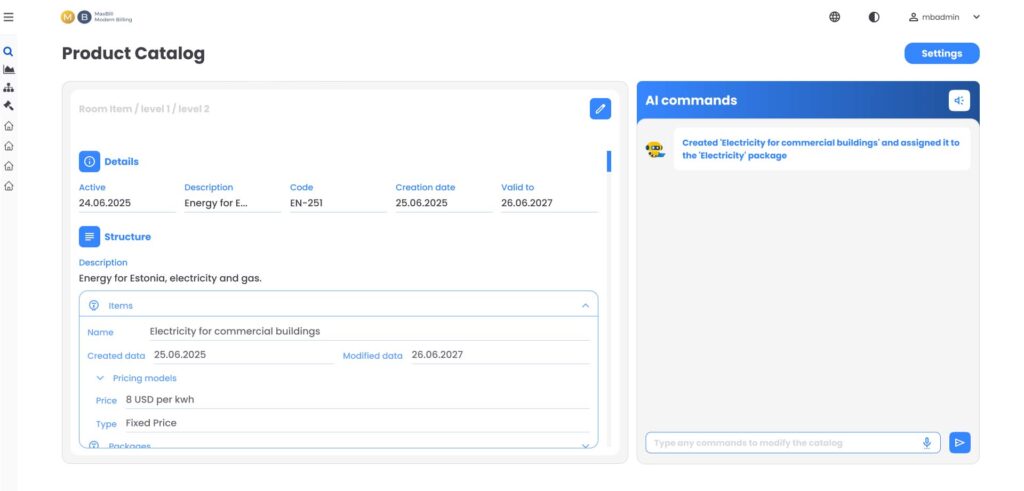
MaxBill has released the AI billing and product catalog to turn complex pricing models into product catalogs and create portfolios – literally in minutes. The same goes for charging – in a matter of clicks. What used to take weeks now is supposed to take minutes.
The good news is that there’s no need for the implementation project, as it is available here and now.
So, what do AI algorithms do?
- Interpreting contracts or plain text to automatically generate billing structures, which reduces setup time by up to 90%.
- Supporting rapid deployment of new features and services, which facilitates expansion into new markets with minimal setup.
- Adapting to evolving rules, pricing, and billing cycles without manual updates ensures seamless compliance and responsiveness.
- Automation leads to approximately 30% savings in ops by minimising manual intervention.
- Providing insights into optimal offers, which potentially results in a 10–15% increase in revenue through better-targeted services.
- Supporting multi-tenancy, multiple languages, and currencies, with real-time process optimisation through large language model agents.
In the context of the whole AI revenue cycle management, the brightest sides of AI billing are automation and transparency. The latter ensures visibility and clarity of revenue sharing and financial settlements, which ensures revenue leakage prevention and healthy case flow, in the first place.
Related:
Webinar: Top Trends Driving Revenue in Energy & Utilities in Sweden 2025
Tips for CIOs: how to implement AI in energy & utilities
Best Practices
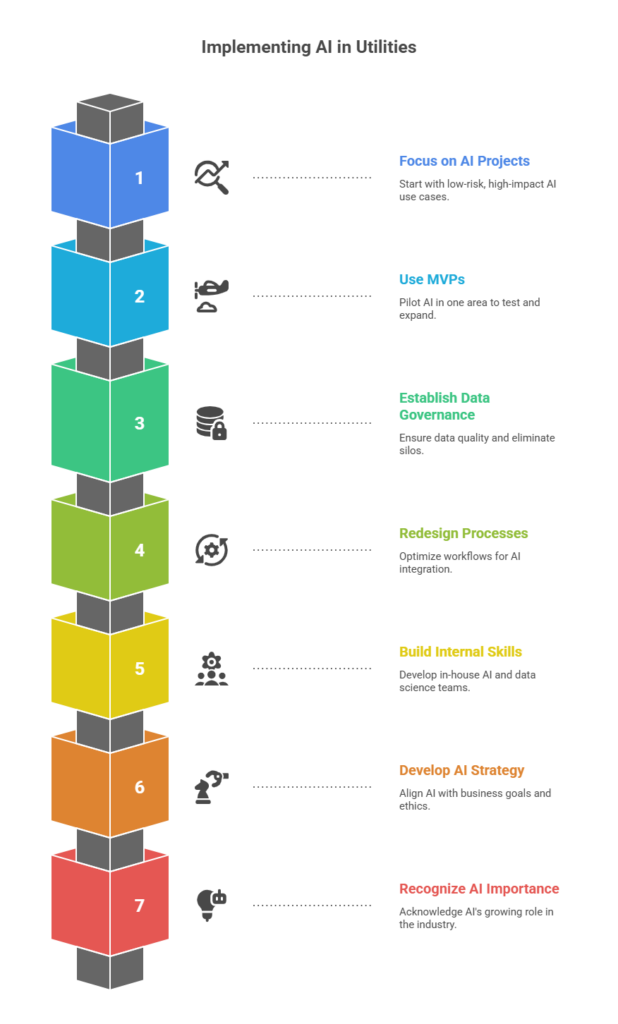
Let us define the top 7 universal recommendations that utility CIOs will definitely find helpful:
- Focus on AI projects with clear business value and preferably start with low-risk, high-impact use cases. These might be forecasting, document triage, or admin automation.
- Large proof-of-concept efforts are gone. It’s risky and expensive. Therefore, use minimum viable products (MVPs). Plus, it’s more optimal to pilot in one area, then expand based on results.
- Data often flows unprepared for further use. Establish data governance and eliminate internal silos, and then monitor its veracity, reliability, and relevance.
- Before implementing AI, redesign processes and workflows. Teams can start with operational areas (like asset performance or customer experience) where automation and prediction offer immediate efficiency gains. It’s important to notice that force majeure situations occur, and algorithms might not be trained for certain ‘fires’ in the company. So, human supervision is still necessary.
- Building internal skills should be one of the company’s priorities. External vendors will definitely help out, but it’s better to reduce such reliance over time by building internal data science and AI teams.
- Have a clear strategy and governance framework around AI, aligned with business goals and appetite. The AI implementation roadmap has to include AI ethics, legal, and cybersecurity guardrails from the start.
- Teams of any level should recognise: AI is “creeping” into every tool and doing nothing is riskier. Competitors are already leveraging AI to deliver greater service.
In the meantime, the AI application is not a one-time transformation. So, utilities should set expectations realistically and iterate on AI solutions, keeping in mind a long game.
ROI Examples
ROI from implementing AI is not something easy to predict. Outcome quality depends on each company’s legacy infrastructure, data quality, or internal processes. Some cases are hard to quantify up front in a traditional ROI model.
Costs, risks, and returns vary widely across use cases, which makes a standard ROI estimation difficult. Training costs and process redesigns add layers of complexity to measuring return.
Besides, AI is often implemented alongside other digitalisation efforts, such as smart meters, new CRM, and remote diagnostics. So, it’s hard to say how much benefit comes specifically from AI.
In most cases, utilities do not publicly disclose ROI from AI. However, here are real-life cases where ROI is well stated:
Enel (Italy) – Telegestore smart metering
€500 million savings /year vs. a total investment of ~€2.1 billion
The company implemented Telegestore nationwide, a smart-meter system integrated with AI and remote diagnostics. The teams optimised remote meter reading, automated fault detection, and billing.
Creos (Luxembourg) – smart meters and digital twin
Exact € savings aren’t listed; results are enhanced accuracy in asset utilisation and peak management, driving cost reduction.
The company deployed 300,000 smart electricity and gas meters and created digital twin for AI-enabled real-time grid analytics.
Greek TSO – digital twin load forecasting
ROI is not directly stated monetarily; results are improved forecast accuracy and operator confidence.
The national TSO created the digital twin, applied AI models to predict day-ahead electricity loads under various scenarios.
Artificial intelligence in energy and utilities: Summing up
Whether you leverage AI for utilities or not will define the future success of your organisation. Utilities should start with low-complexity, high-impact applications like an AI-powered self-service portal and avoid a rip-and-replace project.
Additionally, it’s critical to have clear business goals. If there’s no defined use case, companies risk investing in AI that “looks good on paper” but doesn’t deliver measurable value.
With the right partner, AI can plug into existing systems, transform processes, and bring desirable outcomes.

AI in utilities FAQ
What is Artificial Intelligence in energy and utilities?
AI in the energy sector and utility is the area of integration AI-driven solutions into operating business models of energy and utility service providers with the purpose of optimizing operations, sustaining low cost to serve approach, serving better customers, which leads to increased bottom line.
What are the latest technology trends in the utilities industry?
You can find the following latest technology trends in the utilities industry:
- AI and predictive analytics and grid and customer ops
- AI-powered customer experience and self-service
- Digital twins for grid modeling and resilience (e.g., outages in Spain and Portugal would confirm the need for digital twins)
- Management of DER and VPP
- Smart metering 2.0 and real-time customer insights
- Cybersecurity and zero trust architecture
- Automation of regulatory compliance and ESG reporting
- Grid edge intelligence and edge computing
- Composable (modular, API-first) platforms and interoperability (solar+battery bundles)
- Digital marketplaces and Energy-as-a-Service (EaaS)
Is AI cost-effective for small utility companies?
Yes, AI is cost-effective for small utilities provided it addresses first low-complexity, high-impact use cases and avoids infrastructure bloat. On the other hand, developing in-house AI systems can be too expensive and slow to deliver ROI to small utilities. Additionally, if it adds tech overhead, the operational burden can outweigh benefits.
How can utilities measure the ROI of AI investments?
First, utilities should define before-and-after metrics tied to cost savings, efficiency, and customer outcomes (e.g., fewer call center tickets, reduced churn, faster billing). There’s a universal formula of calculating ROI:

Additionally, organizations should include both tangible (cost reduction, revenue uplift) and strategic benefits (customer satisfaction, automation gains) over a defined time frame.
What are common AI mistakes for utilities?
AI mistakes for utilities include piloting a project without clear business goals, feeding bad quality data that limits AI accuracy; and overcomplicating the solution.
What’s the future of AI in the energy sector?
AI is gaining traction as energy providers are getting low-risk successful pilots and are ready to expand AI-capabilities of their companies. Around 65-70% of major UK utility companies (including electricity, water, and gas providers) have integrated at least one AI-driven solution into their operations by 2025.
What’s the role of AI in renewable energy?
AI plays a critical role in ensuring the energy transition in the EU. It accelerates the adoption, efficiency, and management of renewable energy. By leveraging data, automation, and predictive capabilities, AI helps overcome many challenges associated with renewable energy sources such as solar, wind, and hydro power.
What is AI billing?
AI Billing nowadays is a part of AI solutions in complex revenue cycle management. MaxBill AI billing allows for client onboarding, creating product packages and services, turning pricing models into catalogs and portfolios, and charging – in clicks. It decreases service and product time-to-market up to 80%.
What is AI in revenue cycle management?
AI brings efficiency, reduced costs, and enhanced reliability to the entire revenue cycle management. MaxBill revenue cycle management powered by AI delivers robust compliance and audit-ready capacities to organisations as well as revenue reconciliation transparency to stakeholders, investors, and partners.
